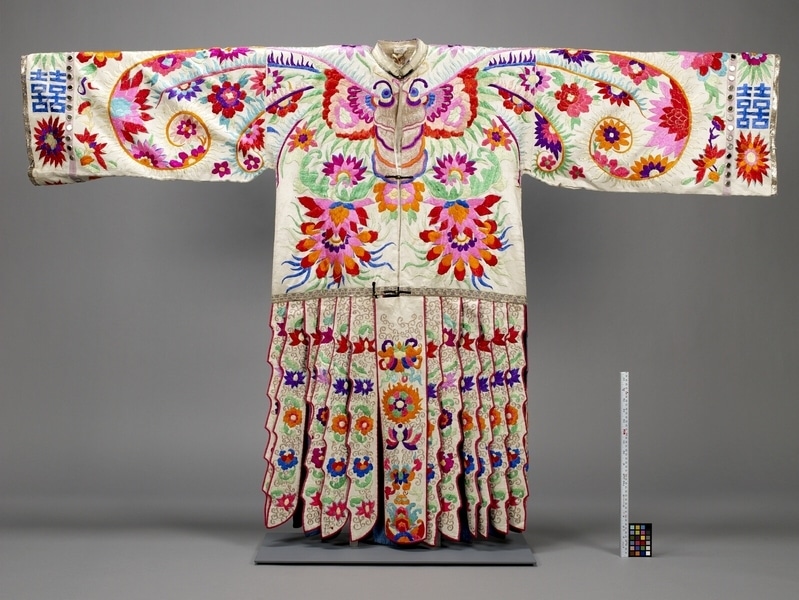Cantonese Opera Robe Item Number: N1.634 from the MOA: University of British Columbia


Description
Woman's palace robe (gongzhuang), ecru coloured with wide sleeves, centre front opening, short, standing collar with brass buttons and panel skirt. Butterfly, peony, chrysanthemum, lotus, narcissus and hsi motifs on the front and back in red, orange, yellow, green, blue, purple on an ecru background. Sleeve bands with a flower and symbol motif in red, orange, yellow, green and blue on ecru ground. There are mirrors on the sleeves. The inside lining is white linen on the upper portion and blue linen on the skirt panels.
History Of Use
Woman’s palace robe (gongzhuang) are fashioned after the ceremonial court robes of the Ming era. They are symmetrical in design and feature colourful skirt panels that sway freely with movements. The robes also have long, flowing sleeves that magnify the performer’s hand gestures. The sleeves could be held in different gestures to express ideals of femininity and/or emotions such as affection, bashfulness or distaste.
Iconographic Meaning
The identification of the costume is indicated by its shape: the centre front closing and the multiple long tabs at the bottom.
Cultural Context
theatre
Narrative
A large group of Cantonese opera costumes, musical instruments, props, trunks, and stage fittings was left with the Jin Wah Sing Musical Association, apparently by some of the many itinerant troupes visiting Vancouver to perform in the Chinatown theatres in the pre-World War II period. There is no certain knowledge of why these materials were not taken back to China by them. They were used by the Jin Wah Sing Musical Association in their performances until they became too dated. The association continued to preserve them carefully, storing them in their headquarters and in the basement of the Chinese Freemasons building until several groups of materials were sold and donated to the Museum of Anthropology.
Specific Techniques
Embroidery is done with long satin stitches, following a pattern marked on the fabric. Floral patterned braid at hip line is machine-woven. Seams are invisible except for those at centre back and collar, which are done by hand. Wear on other costumes made of the same type of fabric reveals that it was woven with a silk warp and cotton weft, or vice versa.
Item History
- Made by Leuhn Cheung Gam Leuhn Cheung (Manufacturer) and Gam San Gung Si (Manufacturer) in Guangzhou, Guangdong, China between 1910 and 1920
- Collected in Vancouver, British Columbia, Canada
- Owned by Jin Wah Sing Musical Association before August 28, 1973
- Received from Barrett Montford Endowment Fund (Funding source), Jin Wah Sing Musical Association (Seller), Leon & Thea Koerner Foundation (Funding source), Museum of Anthropology Donations Fund (Funding source), Mah Society of North America (Funding source), Canada-China Friendship Association (Funding source), Quon H. Wong Agencies (Funding source) and Edith Low-Beer (Funding source) on August 28, 1973
What
- Name
- Cantonese Opera Robe
- Identification Number
- N1.634
- Type of Item
- robe
- Material
- cotton fibre, hemp fibre, silk fibre, gold metal, glass, paste adhesive and brass metal
- Manufacturing Technique
- woven, sewn, stiffened, embroidered and couched
- Overall
- height 126.0 cm, width 192.0 cm
Who
- Culture
- Chinese: Cantonese
- Creator
- Leuhn Cheung Gam Leuhn Cheung (Manufacturer) and Gam San Gung Si (Manufacturer)
- Previous Owner
- Jin Wah Sing Musical Association
- Received from
- Barrett Montford Endowment Fund (Funding source), Jin Wah Sing Musical Association (Seller), Leon & Thea Koerner Foundation (Funding source), Museum of Anthropology Donations Fund (Funding source), Mah Society of North America (Funding source), Canada-China Friendship Association (Funding source), Quon H. Wong Agencies (Funding source) and Edith Low-Beer (Funding source)
Where
- Holding Institution
- MOA: University of British Columbia
- Made in
- Guangzhou, Guangdong, China
- Collected in
- Vancouver, British Columbia, Canada
When
- Creation Date
- between 1910 and 1920
- Ownership Date
- before August 28, 1973
- Acquisition Date
- on August 28, 1973
Other
- Item Classes
- textiles
- Condition
- good
- Accession Number
- 0248/0019